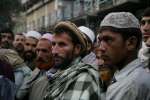UNHCR shelter project helps displaced Afghans rebuild
News Stories, 20 January 2015
EID MAHALA, Afghanistan, January 20 (UNHCR) – Fathiyah* has almost nothing, but says that she still feels rich. The mother of three lost her home and many of her possessions last year, when armed militants forced her family out of their village in northern Afghanistan's Faryab province.
The situation had become increasingly desperate in the village, which the militants visited every night, terrorizing the villagers. Things came to a climax when Fathiyah's brother-in-law was killed, leaving her husband completely traumatized.
Fathiyah realized that the whole family was in grave danger and she quickly decided that she must leave with her husband, two daughters and son. With five other families and a few meagre possessions, they made their way to neighbouring Jawzjan province. "We heard that Sheberghan was peaceful, and we had relatives there," explained Fathiyah, referring to the provincial capital.
Amid stepped up conflict in Faryab over the past year, hundreds of families have fled to safer areas of the province or to neighbouring regions. Last October alone, 1,506 people were registered as internally displaced – the third highest provincial forced displacement rate in the country.
Many uprooted families stay with relatives, but this strains the resources of their hosts. Others, although safe, have almost no possessions, few financial resources and nowhere to stay. But with help from UNHCR and its partners, especially the European Union's Humanitarian Aid and Civil Protection department (ECHO), many of the most vulnerable displaced, including Fathiyah and her family, have been receiving shelter and aid.
Under an ECHO-funded shelter programme, UNHCR is providing materials and expertise for the construction of solid and weatherproof homes for vulnerable returnees, internally displaced people and at-risk local families. More than 4,000 were built in 2014, including the two-room house that will be home to Fathiyah in this village.
Her shelter is nearly complete, with a latrine and a water well nearby. It has been built by skilled workers helped by Fathiyah and her husband. With the arrival of winter in the area, it will provide a safe haven from the elements. "I feel I am rich now," a delighted Fathiyah, who has also received core relief and winter aid items, told UNHCR visitors.
Bo Schack, UNHCR's representative in Afghanistan, highlighted the importance of the programme. "A robust shelter programme is critical to preventing secondary displacement, supporting integration and ensuring families can live in dignity," he stressed.
* Name changed for protection reasons
By Marguerite Nowak in Eid Mahala Village, Afghanistan




















































